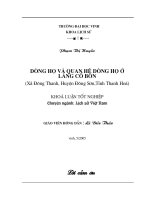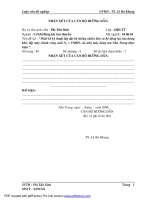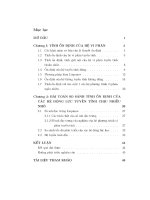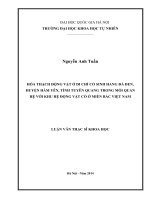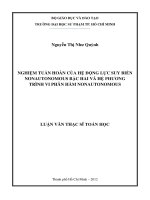On the comparison problem of the stability for non lineaVề bài toán so sánh tính ổn định của hệ động...
Bạn đang xem bản rút gọn của tài liệu. Xem và tải ngay bản đầy đủ của tài liệu tại đây (1.02 MB, 7 trang )
—————
——————
—
OF SCIENCE, Nat.Sci., t.XII, n94 - 1996.
he
VNU. JOURNAL
——————
ON THE COMPARISON PROBLEM OF THE STABILE
FOR NON LINEAR DYNAMICAL SYSTEMS
PERTURBED BY SMALL NOISE
Nguyen Huu Du
Faculty of Mathematics , Informatics and Mechanics
Hanoi National University, Viet Nam*
ABSTRACT
This paper deals with the comparison problem of stability of differential equ
perturbed by non - linear small noise. We suppose that the the linear system
dZ, = a(t,w)Z, dt + A(t,w)Z, dW; ;
Zo =2€ Rt
is strictly stabler than the system
dY, = W(t,w, ¥;)dt + B(t,Y;,w)dM%;
Yo=ye R?
then, under the assumption of the regulity of (1), it is proved
that the system
dX, = (a(t,w)Xe + f(t, Xt) dt + A(t,w)ZedWM; = Zo =z Rt
is strictly still stabler than System (2) provided f(t,x) satisfies the condition
[f(t,2)| < & min{|z|%, z|""?};
œ>1>>0
I. INTRODUCTION
As is known, investigating of the fact whether a given dynamical system is sti
unstable is important in both theory and application.
Therefore, many definitions
stability of systems are given (see, for example, [6], [7],[3]) and there are a vast a
of works dealing with criteria by which we know whenever a given differential equz
stable ( see [6], (7], (3],...). Among these criteria, the Lyapunov exponents of solutic
a powerful tool mainly because of its importance for explaining chaotic behaviour
systems (see [1], [2],...). Furthermore, in order to study the stability of linear syste
general, we have only to consider their Lyapunov exponents.
their trivial solution X = 0 must be stable.
If they are negativ
But as to our knowledge, there is no definition which allows us to compa
”degree” of the development of systems even they are defined in a same space an
the same dimension.
In some cases, this comparison is necessary because many
te:
problems require us to choose a system which is the less chaotic the better ama
given systems.
On the other hand, studying the Lyapunov exponent of a function means t
compare this function with exponential functions. However, the class of expo
Hoa,
* The work is done under the support of Seminar of ” Numerical Analysis” monitored by Ph.D Ngu
Faculty of Mathematics,
Mechanics
and Informatics.
30
contains not many informations of growth rates because they are monotonous.
re, if we
replace
this class
by
a larger one,
we
hope
to have
more
informations
behaviour of the considered function.
‘
ng on this idea we give a concept for comparing the growth rate of two systems.
sical definition of stabilities can be obtained by comparing the considered system
trivial system
X = 0.
ides, by Lyapunov Theorem for the. Stability (see [4],pp. 267), if the linear system
jentialy stable then it is still stable under small noise. We want here to generalise
ult in the point of view of preserving the “order” of stabilities. It is proved that
m (1) is stabler than (2), then it is stabler than (2) under small non linear noise.
2 article is organized as follows: Section II introduces a definition for comparing
vility between two systems whose states are described by stochastic equations in
ce of real noise or white noise and we give some remarks on this definition. In
IIIf, we formulate the main result. It is shown that under the small noise f(t,z)
: regulity of the linear system, System (3) is stabler than (1).
Il. COMPARISON
OF GROWTH
RATE OF DYNAMICAL
(Q,Z,. t > 0, P) be a stochastic basis
SYSTEMS
satisfying the standard conditions (see [5])
1.4 > 0) be ad- dimension wiener process defined on (9, Z¿, t > 0, P). We consider
astic system
described
by the following equation
{ dX,
Xo
=a(t,X,,w)dt + A(t, X;,w)di
(2.1)
=reRrt
or all x € R4 , ((a(t,r)) and (A(t, x) are two stochastic processes F,- adapted with
n ?? and in the space of dx d- matrices respectively such that
a(,0Z0 —
pose
A(0)=U
that for any x € Rt, Equation
P=as
(2.2)
(2.1) has a unique strong solution.
Let us
he classical definition of stability in Lyapunov’s sense. Denote by X(t,z,w) the
1 of (2.1) starting from x at t= 0. From (2.2), it follows that X =0 is a solution
ation (2.1).
jon 2.1.
The trivial solution X = 0 is said to be stable if for any «> 0
lim p( ott,
sup | |X(t,r,w)|
jim
(t.2,w)| >> ¢ ) =0
5] pp.
limcans
206 ).
we
K(t,2,w)| <
|
pret
(2.3) 2.3
It is known that in fact considering whether a system
compare its ‘solutions
means
with
|X(t,2,w)| < ¢(t)
constant
functions
because
for any 1 > 0 where
that this definition gives no information
when
the
is stable
relation
(() =cVt>0.
the solution X(t,z) tends to
ye or to 0. Thus it requires us to consider a larger class of functions to know more
avior of systems. We now realise this idea.
ide of Equation (2.1) we consider the equation
|
{ dY,
Yo
= (t,Yi,w)dl + BL, Y;, wd
44
= yo € Ke”
oe y)) and (B(t,y)) satisfy the same hypothesis as (a(t,y)) and (A(t, y)), ie.
6(t,0)=0
H(,0)8U
31
W>0
P-as
(2.5)
We writé for Y(t, x) thé solution of (2.4) starting from „ at £ = 0
Let C the set of all’ positive continuows furtctions from
[0,00) into Rt and
subset of C.
Defitiitfoti 2.2. The trivial solution X = 0 of System (2.1) is said to be stabler t
solution Y = 0 of System (2.4) in the comparing class M if for any q € M, the rel
follows that
Definition
Tiny P{lY(,v)|<œ
for all. t>0} =1
lim P{\X(t,z)|
forall
2.2 is an extension
following theorem.
44
|
t>0}=1
of the classical one of stability.
Indeed, we h
Theovem 2.3; System (2.1) is stable in sense of (2.3) if it is stabler than the trivial
Ÿ=0,
Yo=ueR“2
on the class C.
Proof: If (2.1) is stabler than (2.8), then it is easy to see that (2.1) is stab
every solution of (2.8) is constant. Inverselly, suppose that (2.1) is stable and q
dat
0
q: = 0 then Equality (2.6) does not hold.
Meanwhile
if
inf
Hods which implies that
18 lim P(
ice System
Theorem
sup
0
[X(t,z)|
b> 0)
(2.1) is stabler than System (2.4). Moreover, it is easy to prove that
2.2:
If MCC
consists of all functions having
every stable system is stabler than any unstable system.
Exaniple:
q=k>0th
0
the exact limit as t —¬
Both two systems
X-X4+2X =0
Ÿ-9Ÿ+2Y
=0
are unstable. But it is easy to see that (A) is stabler than (B) in C.
Ill. LINEAR REGULAR
SYSTEM.
We introduce the so-called regular system as in [4]. Let us consider the lineal
dZ,=AZidt+ Bi2dW,
‘
where
A;,
condition.
B,
are two
ptf
T
0
stochastic
processes
[Ail dt < 00} = Pf f
T
0
with
2a=zeRt
vatues
in
|Bildt
dx
d- matrices
forany
“This condition ensures the existence of strơng sịlutions of (3.1).
32
T>0
satisf
Ì
Z(,z)
be the solution of (3.1) starting from
t. of Z(t,z) defined
z. WWe write for À[z] the Lyapunov
by
Ä{4= lraup : In |Z(t, 2)|
(3.2)
toro
ase where the limit in (3.2) exists, we say that
hs known
that
s of n random
(see
[1], [6]...)
variables, namely,
the Lyapunov
MS A2 Ss
tion 2.3.
(See [4] pp.
165).
System
Z(t,z) has an exact exponent.
spectrum
of the solution of (3.1)
San
(3.3)
(3.1) is said to be regular if there exists a
nental system of solutions Z(t) such that the column
ent and takes all values \;, i= 1,2,...,d in (3.3)
vectors of Z(t) has the exact
t the comparing class M consist of elements ¢ € C having the exact limit
1 SES
(3.4)
teeoe t
y that (2.1) is strictly,stabler than (2.4) if the condition (2.7) is replaced by: There
M
such that ạ* < ÿ and
lim PUX(L2)
ently stable.
(2.1) is strictly
Wi>0)=1
stabler than
(2.7)
(2.8) in M
if and
only
if (2.1) is
‘em 3.2. Suppose that (3.1) is regular and strictly stabler than the system
dy; =a(t,¥i)dt+o(t,YdWi
= Yo
ye Rt
(3.5)
the perturbed system
AX, =(AdXi + ft, Xd] t+ BX dW, = Xo =z RE
| strictly stabler than (3.5).
ndition:
There
|
Where f(t,r) is a locally Lipchitz function satysfying
are constants œ >1
> >0;
K>0
such
that
J/ứŒ.,z)| < K. min(|z|*, |zl'~)
roof:
From
the assumption
(3.6)
(3.7)
of the regulity of (3.1), we can find a fundamental
n of solutions of (3.1), namely Z(t), such that: if
&(t) = Z(t).exp{-At},
A = diag{A1, Ao)... Aa}
. 7 In |(¢)| = jim [In
aO-"(0)| = 0
fim,
fore, for any y > 0 there is a random
(3.8)
variable N such that
|Z().Z—!@@)|< N.exp[(u+3t~Ou—+)3) — Pa
33
(3.9)
_
-
=—_
Let ạ€ A4 such that
Jìm P(Y@,9| <&
a
Wt>0}=1
Since (3.1) is strictly stabler than (3.5), then there exists g* € 4,
lim P{|Z(9z| <4
đ° < đ anl
Wr>0}=1
This equality implies Ag < 7 < q. Therefore, we can choose + in the inequaliv (3.
that
(*)
<1
and
(**)
Àa+>+<1
Aa++y<
and
when
Àz>0
(a—1)Ag+(a+1)y<0
when
Az<0
It is easy to see that (3.16) is equivalent to
X.=Z()z+ ƒ Z().Z~'(s)ƒ(s, X,)ds
Therefore
IXi
We consider two cases:
a). Aa>0
By (3.13) and (3.9) we get
'
1X1)
Ix,1-Pa
= exp{(Àa+ +)t}[out + Kw f , exp{((2- B)y — Bda) .8}-le" OF X,!~8a,
By virtue of of Bihari’ s inequality ( see [4] pp.
LX¡| < exp{(Aa + +)} [er
where
z:
o =: (2 — 8)y — Ba.
|z|<1
we have
Hence,
there
|Xi|< M.exp[(Au+++Ø))
110 ) we get
+BK.N | exp{os} as}
Ỷ
0
exists
a random
Peas
variable
where
P-as
M
such
that
F= max(0.5)
For any ¢ > 0 fixed, it follows from (3.12 («)) that there exists a random 7; >0 su
P{M.exp{(Aa+++ỡ)t} < &
Wt>T;} >1-<«/2
On the other hand, on (0,7;], the solutions X(t,z) depend continuously o1 the
condition z, then we can choose an 6 > 0 such that
P{lX(tz)|<œ
Wee [0,Ti]}>1-«/2
34
when - |r|<ð
(3.14) and (3.15) it yields
P{|X(t,2)1
Wes 0}
>1-«
when
Iz] <6
ns that (3.6) is stabler than (3.5).
Using (3.13) we have
‘
IXI< |Z(9z|+-+KÍ IZ():Z”!09)11X,If4s
0
< eet IN Jel + Kw [ exp{(A+-1)8 — (da — x)s)|X;|* đa]
0
f
=:(a — LÀ¿ + (ø + 1)y
[4], ‘pp 110), it yields
virtue of Bihari’s inequality which a > 1 (see
N feolexp{(Aa + 04}
Xứ.z)Ì<——————
— ——
=
[1 = (a= D]zol9=!
x fi ee ds] =
p is small.
ng the same argument as above, we conclution that Ve > 0, there is an 6 > 0 such
|z| <6 then
PAX(z)]
E> 0) >1-€
the result follows.
wy 3.3 (See [4] pp.267 ). If the top Lyapunov exponent of (3.1) is negative, then
turbed system (3.6) is stable.
le 3.4
The
assumption
of regulity
of (3.1) is satysfied"when
(A;) and
(B;) are
tionary processes. The matter of fact is that is that in this case (3.2) generates a
2 (Z(t)) and by Floqué’s representation( see [1] and [2])
0
“a
Z(t) = S(t)exp{At + o(t)},
as too
S(t) is a random process with values in the sphere {z € Ré: |z|= 1}
} note that Theorem 3.2 may not be true if conditions 3.7 is violtaed as the following
PP
hs 3.5 Let us conside the logistic equation
dX, = (aX, + YX )dt + 0.X,0dW,
(3.15)
denotes the Stranovich equation. It is easy to see that (3.15) has the solutions
|X| = z.exp{œt + ø.W,} x {IzalŸ +
|
+
ff cxp{~5(as + o.W,)}ds}*
ọ
other hand System (3.15) is a perturbation of
đZ, = d.Ø, + ø.Z, e W,
35
(8.16)
which is stabler than
a
dY, Y= = —.Y,
oY dt
when a <0. Therefore, (3.16) is stabler than (3.17), but (3.15) is not stabbr tha
1e; the assertion of Theorem
are unstable.
3.2 is not true. We remark that both Systen 3.15
REFERENCES
lôi
bị
L. Arnold. Random Dynamical Systems. 1995. Preliminary Version2
L. Arnold and H. Crauel : Random Dynamical Systems Lyapunov Exonet
ceedings, Oberwolfach 1990; Lecture Note in Mathematics 1486 New York
(4)
1991. Springer.
Bylov, R.E. Vinograd, D.M. Grobman and V.V. Neminskii: Theor; of I
Exponents ; Nauka, Moscow 1966 (Rusian).
B.P. Demidovish : Lectures on the Mathematic Theory of Stability; Nauka,
(5)
and A.V. Skorohod Stochastic Differential Equations ; Syringe:
8]
1967.
I.I. Ghihman
1973.
R.S Khaminskii :Stability of Systems of Differential Equations with Rindon
bations of Their Parameters ;Nauka , Moscow 1969 (Rusian ).
H. Kushner : Stochastic Stability and Control; Academic
N.H.Du.
Spectrum
TẠP CHÍ KHOA
Press , Đ.J. -Lone
On the Relation between Lyapunov Exponents of Linear Systems
of Operators.
HỌC,
KHTN,
Accepted in Acta Vietnam
ĐHQGHN.
t.XII
Matematica
1997
n° 4, 1996
VỀ BÀI TOÁN SO SANH TiNH ON DINH CUs
HE DONG HOC CHIU NHIEU NHO
Nguyễn
Hữu
Dư
Đại học Tự nhiên - Dại học Quốc gia Hà Nội
Bài
báo đưa
ra quan
niệm
mới
về sự sỏ sánh
tính
ổn
định
của hai hệ đ
Định nghĩa cổ điển về ổn định có thể nhận được bằng cách so sánh hệ ta ch
tầm thường. Bài báo cùng đề cập tới việc mở rộng định lý Lyapunov vš tính
theo quan điểm bảo tồn thứ tự ổn định của hệ động học chịu nhiều phi tuyết
36
